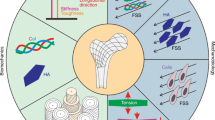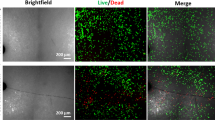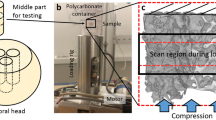Abstract
Our bones are full of cracks, which form and grow as a result of daily loading activities. Bone is the major structural material in our bodies. Although weaker than many engineering materials, it has one trick that keeps it ahead — it can repair itself. Small cracks, which grow under cyclic stresses by the mechanism of fatigue, can be detected and removed before they become long enough to be dangerous. This article reviews the work that has been done to understand how cracks form and grow in bone, and how they can be detected and repaired in a timely manner. This is truly an interdisciplinary research field, requiring the close cooperation of materials scientists, biologists and engineers.
This is a preview of subscription content, access via your institution
Access options
Subscribe to this journal
Receive 12 print issues and online access
$259.00 per year
only $21.58 per issue
Buy this article
- Purchase on Springer Link
- Instant access to full article PDF
Prices may be subject to local taxes which are calculated during checkout





Similar content being viewed by others
References
Martin, R. B. & Burr, D. B. A hypothetical mechanism for ths timulation of osteonal remodelling by fatigue damage. J. Biomech. 15, 137–139 (1982).
Martin, R. B. Fatigue damage, remodeling, and the minimization of skeletal weight. J. Theor. Biol. 220, 271–276 (2003).
Burr, D. B. Targeted and nontargeted remodeling. Bone 30, 2–4 (2002).
Tsuji, K. et al. BMP2 activity, although dispensible for bone formation, is required for the initiation of fracture healing. Nature Genet. 38, 1424–1429 (2006).
Burr, D. B. & Martin, B. R. Calculating the probability that microcracks initiate resorption spaces. J. Biomech. 26, 613–616 (1993).
Mori, S. & Burr, D. B. Increased intracortical remodeling following fatigue damage. Bone 14, 103–109 (1993).
Lee, T. C., Staines, A. & Taylor, D. Bone adaptation to load: Microdamage as a stimulus for bone remodelling. J. Anat. 201, 437–446 (2002).
Taylor, D. Fatigue of bone and bones: An analysis based on stressed volume. J. Orthop. Res. 16, 163–169 (1998).
Boyde, A. The real response of bone to exercise. J. Anat. 203, 173–189 (2003).
Frost, H. M. Presence of microscopic cracks in vivo in bone. Henry Ford Hosp. Med. Bull. 8, 25–35 (1960).
O'Brien, F., Taylor, D. & Lee, T. C. An improved labelling technique for monitoring microcrack growth in bone. J. Biomech. 35, 523–526 (2002).
O'Brien, F. J., Taylor, D. & Lee, T. C. Microcrack accumulation at different intervals during fatigue testing of compact bone. J. Biomech. 36, 973–980 (2003).
Vashishth, D. et al. In vivo diffuse damage in human vertebral trabecular bone. Bone 26, 147–152 (2000).
Choi, K. & Goldstein, S. A. A comparison of the fatigue behaviour of human trabecular and cortical bone tissue. J. Biomech. 25, 1371–1381 (1992).
Li, J., Miller, M. A., Hutchins, G. D. & Burr, D. B. Imaging bone microdamage in vivo with positron emission tomography. Bone 37, 819–824 (2005).
Silva, M. J. et al. In vivo skeletal imaging of 18F-fluoride with positron emission tomography reveals damage- and time-dependent responses to fatigue loading in the rat ulna. Bone 39, 229–236 (2006).
Lee, T. C. et al. Detecting microdamage in bone. J. Anat. 203, 161–172 (2003).
Kawahara, D. & Murakami, T. Evaluation for mechanism of diffuse damage in cortical bone. Trans. Jpn Soc. Mech. Eng. A 71, 936–943 (2005).
Qiu, S., Rao, D. S., Fyhrie, D. P., Palnitkar, S. & Parfitt, A. M. The morphological association between microcracks and osteocyte lacunae in human cortical bone. Bone 37, 10–15 (2005).
Sobelman, O. S. et al. Do microcracks decrease or increase fatigue resistance in cortical bone? J. Biomech. 37, 1295–1303 (2004).
Frank, J. D. et al. Aging and accumulation of microdamage in canine bone. Bone 30, 201–206 (2002).
Schaffler, M. B., Choi, K. & Milgrom, C. Aging and matrix microdamage accumulation in human compact bone. Bone 17, 521–525 (1995).
Fazzalari, N. L., Forwood, M. R., Smith, K., Manthey, B. A. & Herreen, P. Assessment of cancellous bone quality in severe osteoarthrosis: Bone mineral density, mechanics, and microdamage. Bone 22, 381–388 (1998).
Mori, S., Harruff, R., Ambrosius, W. & Burr, D. B. Trabecular bone volume and microdamage accumulation in the femoral heads of women with and without femoral neck fractures. Bone 21, 521–526 (1997).
Dai, R. C., Liao, E. Y., Yang, C., Wu, X. P. & Jiang, Y. Microcracks: An alternative index for evaluating bone biomechanical quality. J. Bone Miner. Metab. 22, 215–223 (2004).
Muir, P. et al. Role of endochondral ossification of articular cartilage and functional adaptation of the subchondral plate in the development of fatigue microcracking of joints. Bone 38, 342–349 (2006).
Huiskes, R., Rulmerman, R., Van Lenthe, G. H. & Janssen, J. D. Effects of mechanical forces on maintenance and adaptation of form in trabecular bone. Nature 405, 704–706 (2000).
Taylor, D. & Lee, T. C. Microdamage and mechanical behaviour: Predicting failure and remodelling in compact bone. J. Anat. 203, 203–211 (2003).
Nalla, R. K., Kruzic, J. J., Kinney, J. H. & Ritchie, R. O. Effect of aging on the toughness of human cortical bone: Evaluation by R-curves. Bone 35, 1240–1246 (2004).
Nalla, R. K., Kruzic, J. J., Kinney, J. H. & Ritchie, R. O. Mechanistic aspects of fracture and R-curve behavior in human cortical bone. Biomaterials 26, 217–231 (2005).
Malik, C. L., Stover, S. M., Martin, R. B. & Gibeling, J. C. Equine cortical bone exhibits rising R-curve fracture mechanics. J. Biomech. 36, 191–198 (2003).
Nalla, R. K., lken, J. S., Kinney, J. H. & Ritchie, R. O. Fracture in human cortical bone: Local fracture criteria and toughening mechanisms. J. Biomech. 38, 1517–1525 (2005).
Vashishth, D., Tanner, K. E. & Bonfield, W. Experimental validation of a microcracking-based toughening mechanism for cortical bone. J. Biomech. 36, 121–124 (2003).
Yeni, Y. N. & Fyhrie, D. P. A rate-dependent microcrack-bridging model that can explain the strain rate dependency of cortical bone apparent yield strength. J. Biomech. 36, 1343–1353 (2003).
Currey, J. D. Mechanical properties of bone tissues with greatly differing functions. J. Biomech. 12, 313–319 (1979).
Hazenberg, J. G., Taylor, D. & Lee, T. C. Mechanisms of short crack growth at constant stress in bone. Biomaterials 27, 2114–2122 (2006).
Akkus, O. & Rimnac, C. M. Cortical bone tissue resists fatigue fracture by deceleration and arrest of microcrack growth. J. Biomech. 34, 757–764 (2001).
O'Brien, F. J., Taylor, D. & Lee, T. C. The effect of bone microstructure on the initiation and growth of microcracks. J. Orthop. Res. 23, 475–480 (2005).
Nyman, J. S., Reyes, M. & Wang, X. Effect of ultrastructural changes on the toughness of bone. Micron 36, 566–582 (2005).
Wang, X., Xiaoe, L. I., Shen, X. & Agrawal, C. M. Age-related changes of noncalcified collagen in human cortical bone. Ann. Biomed. Eng. 31, 1365–1371 (2003).
Zioupos, P., Currey, J. D. & Hamer, A. J. The role of collagen in the declining mechanical properties of aging human cortical bone. J. Biomed. Mater. Res. 45, 108–116 (1999).
Mitchell, E. J., Stawarz, A. M., Kayacan, R. & Rimnac, C. M. The effect of gamma radiation sterilization on the fatigue crack propagation resistance of human cortical bone. J. Bone Joint Surg. A 86, 2648–2657 (2004).
Currey, J. D. Effects of differences in mineralization on the mechanical properties of bone. Phil. Trans. R. Soc. Lond. B 304, 509–518 (1984).
Wasserman, N., Yerramshetty, J. & Akkus, O. Microcracks colocalize within highly mineralized regions of cortical bone tissue. Eur. J. Morphol. 42, 43–51 (2005).
Nyman, J. S. et al. The influence of water removal on the strength and toughness of cortical bone. J. Biomech. 39, 931–938 (2006).
Akkus, O., Yeni, Y. N. & Wasserman, N. Fracture mechanics of cortical bone tissue: A hierarchical perspective. Crit. Rev. Biomed. Eng. 32, 379–425 (2004).
Vashishth, D. Age-dependent biomechanical modifications in bone. Crit. Rev. Eukar. Gene 15, 343–357 (2005).
Turner, C. H., Robling, A. G., Duncan, R. L. & Burr, D. B. Do bone cells behave like a neuronal network? Calcified Tissue Int. 70, 435–442 (2002).
Burger, E. H., Klein-Nulend, J. & Smit, T. H. Strain-derived canalicular fluid flow regulates osteoclast activity in a remodelling osteon — a proposal. J. Biomech. 36, 1453–1459 (2003).
Klein-Nulend, J., Bacabac, R. G. & Mullender, M. G. Mechanobiology of bone tissue. Pathol. Biol. 53, 576–580 (2005).
Bentolila, V. et al. Intracortical remodeling in adult rat long bones after fatigue loading. Bone 23, 275–281 (1998).
Noble, B., Alini, M. & Richards, R. G. Bone microdamage and cell apoptosis. Eur. Cells Mater. 6, 46–55 (2003).
Noble, B. S. et al. Mechanical loading: Biphasic osteocyte survival and targeting of osteoclasts for bone destruction in rat cortical bone. Am. J. Physiol. Cell Ph. 284, C934–C943 (2003).
Colopy, S. A. et al. Response of the osteocyte syncytium adjacent to and distant from linear microcracks during adaptation to cyclic fatigue loading. Bone 35, 881–891 (2004).
Verborgt, O., Gibson, G. J. & Schaffler, M. B. Loss of osteocyte integrity in association with microdamage and bone remodeling after fatigue in vivo. J. Bone Min. Res. 15, 60–67 (2000).
Taylor, D., Hazenberg, J. G. & Lee, T. C. The cellular transducer in damage-stimulated bone remodelling: A theoretical investigation using fracture mechanics. J. Theor. Biol. 225, 65–75 (2003).
Hazenberg, J. G., Freeley, M., Foran, E., Lee, T. C. & Taylor, D. Microdamage: a cell transducing mechanism based on ruptured osteocyte processes. J. Biomech. 39, 2096–2103 (2006).
Huiskes, R. in Non-cemented Total Hip Arthroplasty (ed. Fitzgerald, R.) 283–302 (Raven, New York, 1988).
Prendergast, P. J. & Taylor, D. Prediction of bone adaptation using damage accumulation. J. Biomech. 27, 1067–1076 (1994).
Martin, B. Mathematical model for repair of fatigue damage and stress fracture in osteonal bone. J. Orthop. Res. 13, 309–316 (1995).
Hazelwood, S. J., Martin, R. B., Rashid, M. M. & Rodrigo, J. J. A mechanistic model for internal bone remodeling exhibits different dynamic responses in disuse and overload. J. Biomech. 34, 299–308 (2001).
Nyman, J. S., Yeh, O. C., Hazelwood, S. J. & Martin, R. B. A theoretical analysis of long-term bisphosphonate effects on trabecular bone volume and microdamage. Bone 35, 296–305 (2004).
Heaney, R. P. Is the paradigm shifting? Bone 33, 457–465 (2003).
Taylor, D. & Lee, T. C. A crack growth model for the simulation of fatigue in bone. Int. J. Fatigue 25, 387–395 (2003).
Taylor, D. Scaling effects in the fatigue strength of bones from different animals. J. Theor. Biol. 206, 299–306 (2000).
Tortora, G. J. Principles of Human Anatomy (Wiley, New York, 2002).
Zarrinkalam, K. H., Kuliwaba, J. S., Martin, R. B., Wallwork, M. A. B. & Fazzalari, N. L. New insights into the propagation of fatigue damage in cortical bone using confocal microscopy and chelating fluorochromes. Eur. J. Morph. 42, 81–90 (2005).
Author information
Authors and Affiliations
Corresponding author
Ethics declarations
Competing interests
The authors declare no competing financial interests.
Rights and permissions
About this article
Cite this article
Taylor, D., Hazenberg, J. & Lee, T. Living with cracks: Damage and repair in human bone. Nature Mater 6, 263–268 (2007). https://doi.org/10.1038/nmat1866
Issue Date:
DOI: https://doi.org/10.1038/nmat1866
This article is cited by
-
Delivery of bone morphogenetic protein-2 by crosslinking heparin to nile tilapia skin collagen for promotion of rat calvaria bone defect repair
Progress in Biomaterials (2023)
-
Impact of collar laser microtexturing on peri-implant health and disease: a retrospective clinical study
Clinical Oral Investigations (2022)
-
Serum exosomes from young rats improve the reduced osteogenic differentiation of BMSCs in aged rats with osteoporosis after fatigue loading in vivo
Stem Cell Research & Therapy (2021)
-
Aggravated stress fluctuation and mechanical size effects of nanoscale lamellar bone pillars
NPG Asia Materials (2021)
-
Computed tomography reveals hip dysplasia in the extinct Pleistocene saber-tooth cat Smilodon
Scientific Reports (2021)



